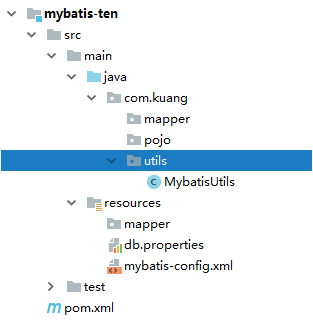10. 动态SQL
10.1. 介绍
什么是动态SQL:动态SQL指的是根据不同的查询条件 , 生成不同的Sql语句.
官网描述:
MyBatis 的强大特性之一便是它的动态 SQL。如果你有使用 JDBC 或其它类似框架的经验,你就能体会到根据不同条件拼接 SQL 语句的痛苦。例如拼接时要确保不能忘记添加必要的空格,还要注意去掉列表最后一个列名的逗号。利用动态 SQL 这一特性可以彻底摆脱这种痛苦。
虽然在以前使用动态 SQL 并非一件易事,但正是 MyBatis 提供了可以被用在任意 SQL 映射语句中的强大的动态 SQL 语言得以改进这种情形。
动态 SQL 元素和 JSTL 或基于类似 XML 的文本处理器相似。在 MyBatis 之前的版本中,有很多元素需要花时间了解。MyBatis 3 大大精简了元素种类,现在只需学习原来一半的元素便可。MyBatis 采用功能强大的基于 OGNL 的表达式来淘汰其它大部分元素。
-------------------------------
- if
- choose (when, otherwise)
- trim (where, set)
- foreach
-------------------------------我们之前写的 SQL 语句都比较简单,如果有比较复杂的业务,我们需要写复杂的 SQL 语句,往往需要拼接,而拼接 SQL ,稍微不注意,由于引号,空格等缺失可能都会导致错误。
那么怎么去解决这个问题呢?这就要使用 mybatis 动态SQL,通过 if, choose, when, otherwise, trim, where, set, foreach等标签,可组合成非常灵活的SQL语句,从而在提高 SQL 语句的准确性的同时,也大大提高了开发人员的效率。
10.2. 搭建环境
新建一个数据库表:blog
字段:id,title,author,create_time,views
CREATE TABLE `blog` (
`id` varchar(50) NOT NULL COMMENT '博客id',
`title` varchar(100) NOT NULL COMMENT '博客标题',
`author` varchar(30) NOT NULL COMMENT '博客作者',
`create_time` datetime NOT NULL COMMENT '创建时间',
`views` int(30) NOT NULL COMMENT '浏览量'
) ENGINE=InnoDB DEFAULT CHARSET=utf8- 创建Mybatis基础工程

-
IDutil工具类
public class IDUtil {
public static String genId(){ return UUID.randomUUID().toString().replaceAll("-",""); }}
-
实体类编写 【注意set方法作用】
import java.util.Date;
public class Blog {
private String id; private String title; private String author; private Date createTime; private int views; //set,get....}
-
编写Mapper接口及xml文件
public interface BlogMapper {
<?xml version="1.0" encoding="UTF-8" ?> <!DOCTYPE mapper PUBLIC "-//mybatis.org//DTD Mapper 3.0//EN" "http://mybatis.org/dtd/mybatis-3-mapper.dtd"> <mapper namespace="com.kuang.mapper.BlogMapper"> </mapper>
} -
mybatis核心配置文件,下划线驼峰自动转换
<settings> <setting name="mapUnderscoreToCamelCase" value="true"/> <setting name="logImpl" value="STDOUT_LOGGING"/> </settings> <mappers> <mapper resource="mapper/BlogMapper.xml"/> </mappers> -
插入初始数据
编写接口
//新增一个博客
int addBlog(Blog blog);sql配置文件
<insert id="addBlog" parameterType="blog">
insert into blog (id, title, author, create_time, views)
values (#{id},#{title},#{author},#{createTime},#{views});
</insert>初始化博客方法
@Test
public void addInitBlog(){
SqlSession session = MybatisUtils.getSession();
BlogMapper mapper = session.getMapper(BlogMapper.class);
Blog blog = new Blog();
blog.setId(IDUtil.genId());
blog.setTitle("Mybatis如此简单");
blog.setAuthor("狂神说");
blog.setCreateTime(new Date());
blog.setViews(9999);
mapper.addBlog(blog);
blog.setId(IDUtil.genId());
blog.setTitle("Java如此简单");
mapper.addBlog(blog);
blog.setId(IDUtil.genId());
blog.setTitle("Spring如此简单");
mapper.addBlog(blog);
blog.setId(IDUtil.genId());
blog.setTitle("微服务如此简单");
mapper.addBlog(blog);
session.close();
}初始化数据完毕!
10.3. if语句
需求:根据作者名字和博客名字来查询博客!如果作者名字为空,那么只根据博客名字查询,反之,则根据作者名来查询
-
编写接口类
//需求1
List<Blog> queryBlogIf(Map map); -
编写SQL语句
<select id="queryBlogIf" parameterType="map" resultType="blog"> select * from blog where <if test="title != null"> title = #{title} </if> <if test="author != null"> and author = #{author} </if> </select> -
测试
@Test
public void testQueryBlogIf(){
SqlSession session = MybatisUtils.getSession();
BlogMapper mapper = session.getMapper(BlogMapper.class);HashMap<String, String> map = new HashMap<String, String>(); map.put("title","Mybatis如此简单"); map.put("author","狂神说"); List<Blog> blogs = mapper.queryBlogIf(map); System.out.println(blogs); session.close();}
这样写我们可以看到,如果 author 等于 null,那么查询语句为 select from user where title=#{title},但是如果title为空呢?那么查询语句为 selectfrom user where and author=#{author},这是错误的 SQL 语句,如何解决呢?请看下面的 where 语句!
10.4. Where
修改上面的SQL语句;
<select id="queryBlogIf" parameterType="map" resultType="blog">
select * from blog
<where>
<if test="title != null">
title = #{title}
</if>
<if test="author != null">
and author = #{author}
</if>
</where>
</select>这个"where"标签会知道如果它包含的标签中有返回值的话,它就插入一个'where'。此外,如果标签返回的内容是以AND 或OR 开头的,则它会剔除掉。【这是我们使用的最多的案例】
10.5. Set
同理,上面的对于查询 SQL 语句包含 where 关键字,如果在进行更新操作的时候,含有 set 关键词,我们怎么处理呢?
-
编写接口方法
int updateBlog(Map map);
-
sql配置文件
<update id="updateBlog" parameterType="map"> update blog <set> <if test="title != null"> title = #{title}, </if> <if test="author != null"> author = #{author} </if> </set> where id = #{id}; </update> -
测试
```java
@Test
public void testUpdateBlog(){
SqlSession session = MybatisUtils.getSession();
BlogMapper mapper = session.getMapper(BlogMapper.class);
HashMap<String, String> map = new HashMap<String, String>();
map.put("title","动态SQL");
map.put("author","秦疆");
map.put("id","9d6a763f5e1347cebda43e2a32687a77");
mapper.updateBlog(map);
session.close();}
【演示】SQL分析
### 10.6、choose语句
有时候,我们不想用到所有的查询条件,只想选择其中的一个,查询条件有一个满足即可,使用 choose 标签可以解决此类问题,类似于 Java 的 switch 语句
1. 编写接口方法
```java
List<Blog> queryBlogChoose(Map map);-
sql配置文件
<select id="queryBlogChoose" parameterType="map" resultType="blog"> select * from blog <where> <choose> <when test="title != null"> title = #{title} </when> <when test="author != null"> and author = #{author} </when> <otherwise> and views = #{views} </otherwise> </choose> </where> </select> -
测试类
@Test
public void testQueryBlogChoose(){
SqlSession session = MybatisUtils.getSession();
BlogMapper mapper = session.getMapper(BlogMapper.class);HashMap<String, Object> map = new HashMap<String, Object>(); map.put("title","Java如此简单"); map.put("author","狂神说"); map.put("views",9999); List<Blog> blogs = mapper.queryBlogChoose(map); System.out.println(blogs); session.close();}
【演示】SQL分析
10.6. SQL片段
有时候可能某个 sql 语句我们用的特别多,为了增加代码的重用性,简化代码,我们需要将这些代码抽取出来,然后使用时直接调用。
提取SQL片段:
<sql id="if-title-author">
<if test="title != null">
title = #{title}
</if>
<if test="author != null">
and author = #{author}
</if>
</sql>引用SQL片段:
<select id="queryBlogIf" parameterType="map" resultType="blog">
select * from blog
<where>
<!-- 引用 sql 片段,如果refid 指定的不在本文件中,那么需要在前面加上 namespace -->
<include refid="if-title-author"></include>
<!-- 在这里还可以引用其他的 sql 片段 -->
</where>
</select>注意:①、最好基于 单表来定义 sql 片段,提高片段的可重用性
②、在 sql 片段中不要包括 where
10.7. Foreach
将数据库中前三个数据的id修改为1,2,3;
需求:我们需要查询 blog 表中 id 分别为1,2,3的博客信息
-
编写接口
List<Blog> queryBlogForeach(Map map);
-
编写SQL语句
<select id="queryBlogForeach" parameterType="map" resultType="blog"> select * from blog <where> <foreach collection="ids" item="id" open="and (" close=")" separator="or"> id=#{id} </foreach> </where> </select> -
测试
@Test
public void testQueryBlogForeach(){
SqlSession session = MybatisUtils.getSession();
BlogMapper mapper = session.getMapper(BlogMapper.class);HashMap map = new HashMap(); List<Integer> ids = new ArrayList<Integer>(); ids.add(1); ids.add(2); ids.add(3); map.put("ids",ids); List<Blog> blogs = mapper.queryBlogForeach(map); System.out.println(blogs); session.close();}
小结:其实动态 sql 语句的编写往往就是一个拼接的问题,为了保证拼接准确,我们最好首先要写原生的 sql 语句出来,然后在通过 mybatis 动态sql 对照着改,防止出错。多在实践中使用才是熟练掌握它的技巧